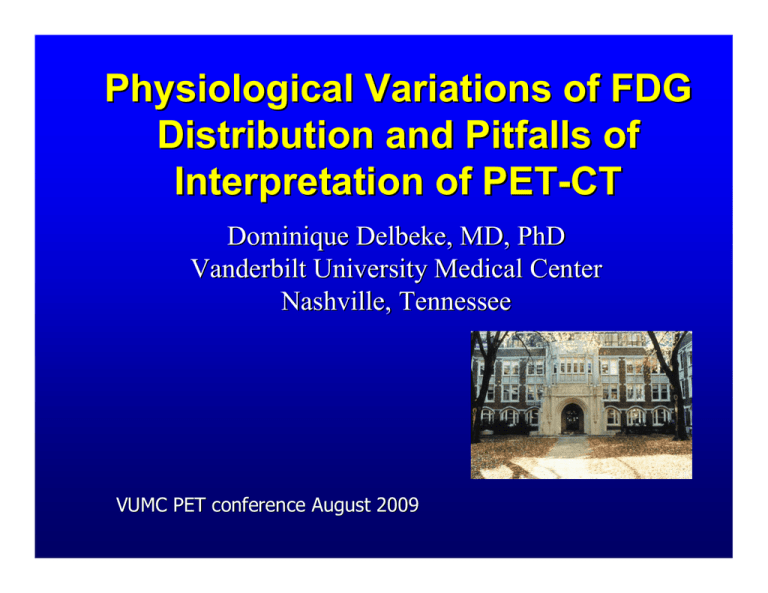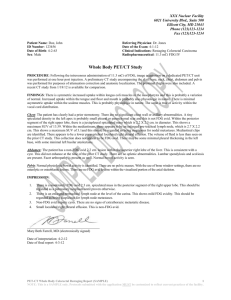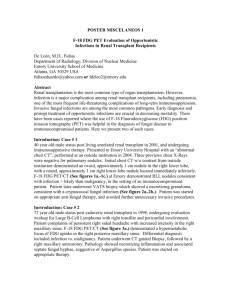Physiological Variations of FDG Distribution and Pitfalls of
advertisement

Physiological Variations of FDG Distribution and Pitfalls of Interpretation of PET-CT Dominique Delbeke, MD, PhD Vanderbilt University Medical Center Nashville, Tennessee VUMC PET conference August 2009 Outline FDG distribution Neck: glandular, lymphoid, muscular Muscular system GI GU GYN Therapy-related changes Inflammatory processes PET technical artifacts PET/CT technical artifacts SNM PET/CT guidelines Preparation of the patient Reporting Normal Distribution of FDG Brain: high uptake in the gray matter Myocardium: variable uptake Lungs: low uptake Mediastinum: low uptake Liver: low uptake GI tract: variable activity (esophagus, stomach, colon) Urinary tract: excretes FDG Muscular system: low uptake at rest Cook GJR, et al: Semin Nucl Med 1996;26:308-314 Physiological Variations of FDG Distribution Neck: Glandular tissue Lymphoid tissue Muscles Brown fat Laryngeal muscles: vocalis and crico-arytenoid Parotid glands Oculomotor muscles Oculomotor muscles nasopharynx Parotid glands Tonsils Sublingual gland and myelohyoid muscles Submandibular glands Laryngeal muscles Patient with lymphoma in remission 6 months earlier Uptake in masseter muscles due to chewing Initial staging lung cancer Uptake in R masseter and pterygoid 67 year-old female with medullary thyroid ca and rising calcitonin Left vocal cord paralysis 16 year old female with lymphoma s/p therapy Brown fat Physiological Variations of FDG Distribution FDG uptake in both the thyroid gland and laryngeal muscles Hashimoto Thyroiditis From: Delbeke D et al (eds): “Practical FDG Imaging: A teaching File” Springer-Verlag 2002. Physiological Variations of FDG Distribution Muscular system: Under tension or after exercise (e.g. chewing, talking, swallowing, eye movement, hyperventilating, walking..) Insulin endogenous or exogenous Exercise Endogenous insulin 51 year-old male with relapse Hodgkin’s lymphoma S/P chemotherapy 36 year-old man s/p lung transplant for hypersensitivity pneumonitis, now lung nodules other patient with lung cancer Respiratory insufficiency 28 year-old male with Hodgkin’s lymphoma and suspected recurrence Nausea and vomiting Weight lifting 22 year-old female with DLBCL s/p completion of therapy Honeymoon effect Physiological Variations of FDG Distribution: GI GI tract: Lymphoid tissue Smooth muscle activity Stools Metformin Inflammatory disease… Crohn’s disease Lung cancer and colitis From: Delbeke D et al (eds): “Practical FDG Imaging: A teaching File” Springer-Verlag 2002. 67 year-old female presents for initial staging of laryngeal cancer Metformin Gontier E et al. Eur J Nucl Med Mol Imaging 2008;35(1):95-99 Physiological Variations of FDG Distribution: GI 45-year-old man who completed chemo and radiation therapy for SCC of the larynx presents with dysphagia Esophagitis 65year-old female with NSCLC referred for initial staging 1) RUL NSCLC 2) Hepatic metastases 3) Hiatal hernia From: Delbeke D et al (eds): “Practical FDG Imaging: A teaching File” Springer-Verlag 2002. Physiological Variations of FDG Distribution: GU Patient evaluated for suspected recurrent colorectal cancer Right pelvic kidney Renal transplant 55-year-old male s/p resection abdominal sarcoma 8 months ago, presenting with suspicion of recurrence on CT abdominal recurrent sarcoma and horseshoe kidney Physiological Variation of FDG Distribution: GU/GYN 36 year old female with a 1 cm SPN Horseshoe kidney and fibroids Physiological Variation of FDG Distribution: GYN 33 year-old female just diagnosed with breast cancer Uterus in a menstruating female 17 year-old female with HD in the neck and chest s/p completion of therapy Ovaries benign Lerman H et al. J Nucl Med 2004;45:266-271. Physiological Variations of FDG Distribution: GYN Dense breast Lactating breasts Vranjesevic D wet al. J Nucl Med 2003;44(8):1238-1242 Monitoring Response to Therapy with FDG PET: Timing in Relation to Surgical Therapy Surgery: ~ 2 months for surgical site Anytime for staging elsewhere. 58 year old man s/p mediastinoscopy 1 week earlier demonstrating NSCLC 62 year-old male s/p resection of recurrent lymphoma of the small bowel 2 weeks earlier. Diagnosis: postoperative changes 45 year-old female with anaplastic lymphoma S/P therapy evaluated for bone marrow transplant July 05 Bone marrow biopsy L iliac crest Monitoring Response to Therapy with FDG PET: Timing in Relation to Radiation Therapy More than 6 months after completion of radiation: FDG uptake indicates tumor recurrence Early after radiation (within 2 months…up to…..): FDG uptake matching the radiation port due to inflammatory changes Recommendations: Wait as long as possible after radiation before performing FDG PET Comparison to baseline PET is helpful Knowledge of radiation ports is helpful. 48 year-old man with HD diagnosed in 2003 48 year old man with lymphoma diagnosed 1 year earlier and treated with XRT to left axilla. He recurred 2 months earlier and was treated with chemotherapy. 57 year old male diagnosed with esophageal cancer in July and treated with chemoradiation completed two weeks before his follow-up PET scan July 29 Oct 19 61 year-old female with T-cell lymphoma of left breast and mediastinum s/p chemo and radiation Radiation esophagitis 33 year-old male with DLBCL s/p chemo and radiation therapy to mediastinum 2 year earlier and referred for restaging Radiation pneumonitis 81-year-old male with large cell carcinoma treated with radiation therapy Radiation pneumonitis From: Delbeke D et al (eds): “Practical FDG Imaging: A teaching File” Springer-Verlag 2002. Monitoring Response to Therapy with FDG PET: Timing in Relation to Chemotherapy Physiological uptake in response to therapy For 2-4 weeks: Bone marrow and spleen due to regenerating bone marrow (hyperplasia) Worse if bone marrow stimulating factors have been administered with chemotherapy (e.g. G-CSF, neupogen) Possible transient cellular stunning Possible inflammatory response: metabolic flare Recommendation: At least 2 weeks after last chemotherapy or just before next cycle 2-months after completion of therapy 1 day post G-CSF A 42-year-old female who underwent a left mastectomy for breast carcinoma followed by chemotherapy presented with rising tumor 2 weeks later markers Diagnosis: Severe bone marrow uptake related to administration of G-CSF the day before Thymic hyperplasia Benign Diseases that Can Mimick Malignancy Granulomatous lesions: e.g. tuberculosis, fungi, sarcoidosis…. Other inflammatory processes Hyperplasia/dysplasia 42-year-old male after completion of therapy for SCC of the oropharynx Sarcoidosis From: Delbeke D et al (eds): “Practical FDG Imaging: A teaching File” Springer-Verlag 2002. 55 year old female with recurrent melanoma 1) Recurrent melanoma in left axilla 2) Vaccine injection in right axilla and bilateral groins 76 year-old male with pulmonary nodule Pericarditis 76 year-old male with pulmonary nodule Recent laminectomy 72-year-old female with weight loss, fatigue, fevers and chills and a lesion in the caudate lobe of the liver on CT Diagnosis: Surgery: Acute gangrenous and hemorrhagic cholecystitis with abscess formation extending in the right colon Suspicion of Klatskin Acute pancreatitis 43 year old s/p thyroidectomy for papillary thyroid cancer presenting with borderline elevation of Tg, has Tg Ab and a negative I-131 scan at time of previous recurrence. Bx: granulomatous disease Nocardia abscess A 80 year-old male with a history of amyloidosis presented for evaluation of SPN Amyloidosis 64-year-old male with recurrent left neck lymphoma post-stem cell transplant From Vitola JV and Delbeke D. Nuclear Cardiology & Correlative Imaging, Springer-Verlag, 2004 60 year old male with NSCLC 2 years earlier presenting with SVC syndrome Thrombus in SVC 68-year-old male with mantle cell lymphoma with multiple LN in the neck and abdomen Diagnosis: 1) False – low grade lymphoma 2) Fem-Fem graft PET Technical Artifacts Malfunctioning detector Injection site Indwelling catheter Sentinel lymph node visualization 57-year-old male with a history of lung cancer believed to be in remission and referred for follow-up Diagnosis: Malfunctioning detector 34-year-old female presents with persistent lympadenopathy in the porta hepatis after completion of therapy for lymphoma Diagnosis: FDG injection in port and visualization of indwelling catheter From: Delbeke D et al (eds): “Practical FDG Imaging: A teaching File” Springer-Verlag 2002. A 65-year-old male with a history of prostate cancer was referred for evaluation of a pulmonary nodule. Arterial injection 60 year old male with multiple relapse of lymphoma, now new 1 cm mediastinal LN Dose infiltration and FDG uptake in sentinel LN Artifacts on CT-attenuated PET images Inaccurate co-registration due to: Random motion less likely with short transmission scan Artifacts on CT-attenuated PET images Inaccurate co-registration due to: Respiratory motion Inaccurate localization of lesion in the region of diaphragm (dome of liver versus lung bases) in 2% of patients Curvilinear cold artifacts along diaphragm 65 year-old with lung cancer s/p XRT to mediastinum 1 week earlier Radiation esophagitis Goerres GW et al. Radiology 2003;226:906-910. Osman MM et al. Eur J Nucl Med 2003;30:603-606. Osman MM et al. J Nucl Med 2003;44:240-243. Artifacts on CT-attenuated PET images Hot spots due to over-correction related to: IV contrast Focal accumulation of oral contrast Metallic implants (dental, hardware…) Overestimation of SUV values by up to 10% compared to Ge68 based attenuation correction. Antoch G et al.J Nucl Med 2002;43:1339-1342. No correction Cohade C et al. J Nucl Med 2003;44:412-416. Goerres GW et al. Eur J Nucl Med Molec Imag 2002;29:367-370. Nakamoto Y et al. J Nucl Med 2002;43:1137-1143. Antoch G et al. J Nucl Med 2004: 45 (Suppl): 56S. standard Thank you! Brazil 2004


